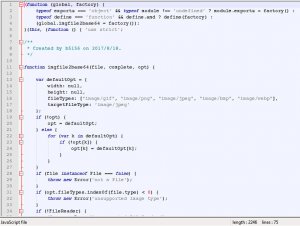JavaScript
 JavaScript - мультипарадигменный язык программирования. Поддерживает объектно-ориентированный, императивный и функциональный стили. JavaScript обычно используется как встраиваемый язык для программного доступа к объектам приложений. Одно из широких применений находит в браузерах как язык сценариев для придания интерактивности веб-страницам.
JavaScript - мультипарадигменный язык программирования. Поддерживает объектно-ориентированный, императивный и функциональный стили. JavaScript обычно используется как встраиваемый язык для программного доступа к объектам приложений. Одно из широких применений находит в браузерах как язык сценариев для придания интерактивности веб-страницам.
JavaScript изначально создавался для того, чтобы сделать web-странички «живыми». Программы на этом языке называются скриптами. В браузере они подключаются напрямую к HTML и, как только загружается страничка – тут же выполняются.
Программы на JavaScript – обычный текст. Они не требуют какой-то специальной подготовки. В этом плане JavaScript довольно сильно отличается от другого языка, который называется Java.
Современный JavaScript – это «безопасный» язык программирования общего назначения. Скрипты JavaScript могут выполняться где угодно, нужна лишь специальная программа – интерпретатор, а сам процесс выполнения скрипта называют «интерпретацией». Практически во все браузеры встроен интерпретатор JavaScript, поэтому они могут выполнять скрипты на странице. Но JavaScript можно использовать не только в браузере. Это полноценный язык, программы на котором можно запускать и на сервере, и даже в игрушечной машинке, если в ней установлен соответствующий интерпретатор.
 Что же касается прочих возможностей – они зависят от окружения, в котором запущен JavaScript. В браузере JavaScript умеет делать всё, что относится к изменениям страницы, взаимодействию с посетителем и, в какой-то мере, с сервером, но в отличии от PHP JavaScript выполняется на стороне клиента, а не сервера. Есть минимум три положительные особенности JavaScript:
Что же касается прочих возможностей – они зависят от окружения, в котором запущен JavaScript. В браузере JavaScript умеет делать всё, что относится к изменениям страницы, взаимодействию с посетителем и, в какой-то мере, с сервером, но в отличии от PHP JavaScript выполняется на стороне клиента, а не сервера. Есть минимум три положительные особенности JavaScript:
- Полная интеграция с HTML/CSS.
- Язык довольно простой и его обучение не требует высокоумных знаний.
- Он поддерживается всеми распространёнными современными браузерами и по умолчанию включен.
Три эти вещи одновременно отсутствуют в других браузерных технологиях, поэтому JavaScript и является самым распространённым языком браузерных интерфейсов.

